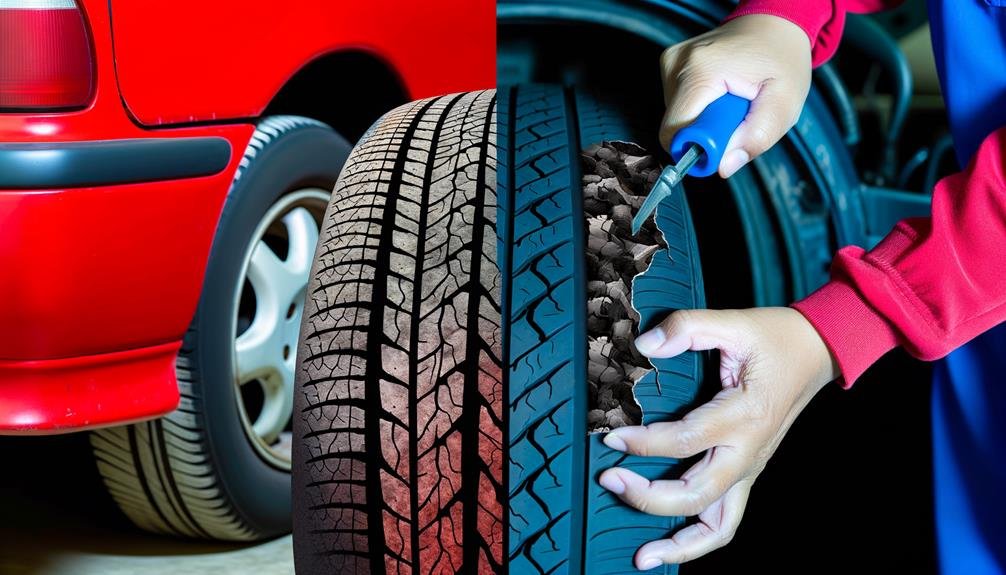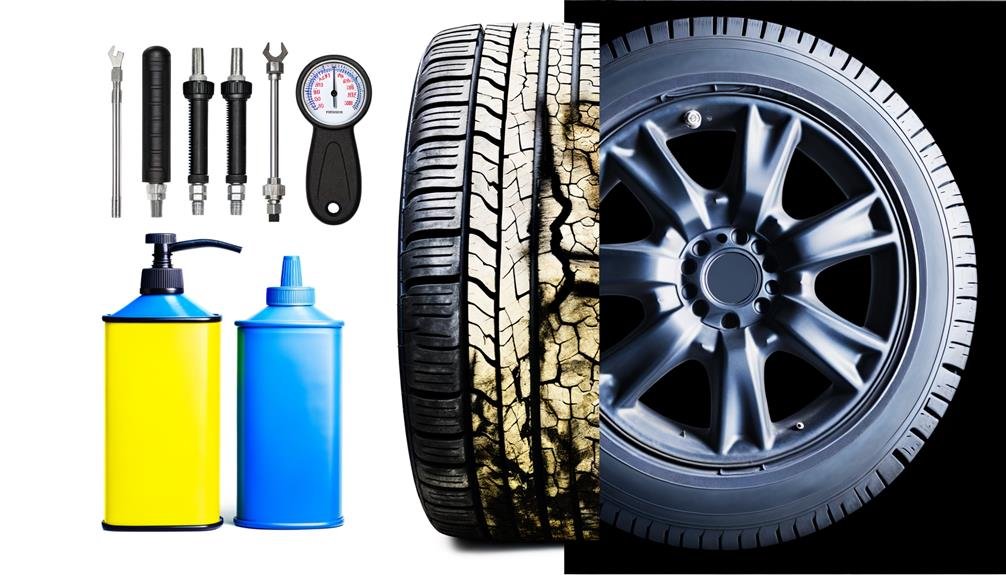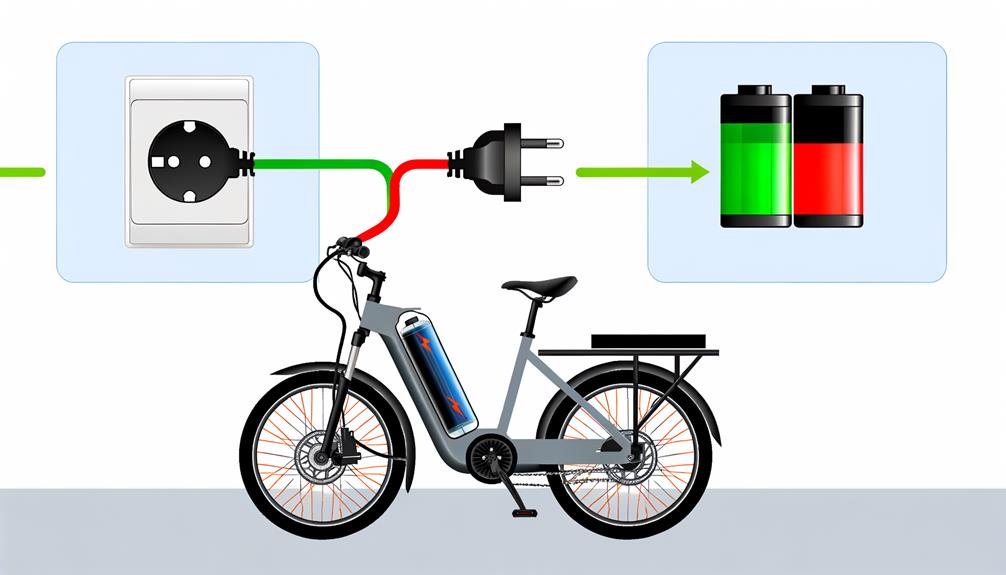Charles Miller is a veteran bike enthusiast with over 12 years of experience dealing with bikes as a mechanic. Despite immense love and expertise for...
Just as a mirror reflects the truth of our appearance, tire cracks reveal the health of our vehicles. We've all seen minor cracks on our tires and wondered how much is too much? Is it merely a cosmetic issue, or should it cause us deeper concern?
The truth is, not all tire cracks are created equal. Some are harmless while others can signal a serious threat to our safety. So how do we differentiate between the two?
Continue with us as we navigate the twisted roads of tire cracking.
- Key Takeaways
- Understanding Tire Cracking
- Common Causes of Tire Cracks
- Dangers of Cracked Tires
- Recognizing Unsafe Sidewall Cracks
- The Lifespan of Tires Before Cracking
- Repairing Vs Replacing Cracked Tires
- Preventing Tire Cracking
- Protective Measures for Rubber Tires
- Frequently Asked Questions
- Conclusion
Key Takeaways
- Tire cracking is caused by environmental stressors, wear and tear, and manufacturing defects.
- Cracked tires can lead to compromised integrity and safety risks, including sidewall blowouts.
- Assessing the severity of sidewall cracks is crucial for safe driving conditions.
- Knowing when to replace tires due to unsafe sidewall cracks is essential, considering factors such as crack size, location, age of the tire, and storage conditions.
Understanding Tire Cracking
To fully grasp the concept of tire cracking, we must delve into the intricacies of tire composition and the environmental factors that contribute to its degradation. Understanding tire cracking begins with acknowledging the harsh reality that tires aren't impervious. They're made from a mix of natural and synthetic rubbers, fabric, wire, and a range of chemical compounds. Over time, these materials react to environmental stressors such as heat, cold, moisture, and oxygen, causing the notorious tire cracks.
Now, how much tire cracking is too much? That's a loaded question. While minor cracking mightn't immediately compromise your safety, extensive or deep cracks can be a significant concern. It's essential to note that tire cracks aren't merely an aesthetic issue. They're a potential safety hazard, a silent warning that your tire's structural integrity might be compromised.
As we journey together in this understanding, remember, tires aren't just a vehicle component. They're a crucial part of our safety, the only point of contact between us and the road. So, let's not just understand tire cracking; let's learn, act, and drive safer.
Common Causes of Tire Cracks
Having established the importance of understanding tire cracking and its potential implications on safety, we now turn our focus to exploring the common causes of tire cracks. Cracked tires are not just an unsightly annoyance; they're a serious safety concern that can lead to catastrophic failure if not addressed.
The common causes of tire cracks can be grouped into three main categories: environmental factors, wear and tear, and manufacturing defects.
| Cause Category | Examples | Effect on Tires |
|---|---|---|
| Environmental Factors | Exposure to UV light, contact with oils and chemicals | Causes tire to degrade, leading to minor and potentially growing cracks |
| Wear and Tear | Regular use, dry rot underneath the tread, reduction in tire flexibility | Leads to growing cracks and underlying structural issues |
| Manufacturing Defects | Poor quality control during production | Results in premature tire cracking |
It's vital to promptly address these causes to prevent tire cracking. Regular inspections can help spot early signs of cracking and mitigate risks. Remember, when it comes to cracked tires, prevention is always preferable to dealing with potential hazards.
Dangers of Cracked Tires

While minor and superficial cracks may seem harmless, the escalating danger lies in the potential for these cracks to grow, leading to fast wear down of tires, compromising tire integrity, and posing serious safety risks. The dangers of cracked tires extend beyond mere inconvenience.
Tire cracks can easily transform minor issues into major disasters. As part of our driving community, we must all be aware of these threats. For instance, a sidewall blowout could result from cracks that reach the tire tread, posing a risk to drivers and other vehicles alike. Such a blowout could lead to loss of control on the road, causing accidents.
Manufacturing defects in newer tires may also contribute to tire cracking. Such defects can weaken the structural integrity of the tire, making it more susceptible to cracks. So, it's not just about the age of the tire, but its overall condition.
Prevention is key. Proper storage, regular cleaning, and maintaining correct inflation can help. However, remember that tires have an expiration date, usually between 6 to 10 years. Safety should always trump cost considerations when it comes to replacing cracked tires.
Recognizing Unsafe Sidewall Cracks
We'll now turn our attention to recognizing unsafe sidewall cracks.
We need to accurately identify the severity of these cracks, understand the risks of ignoring them and familiarize ourselves with the guidelines for tire replacement.
It's crucial that we grasp these points fully to ensure our safety on the road.
Identifying Sidewall Crack Severity
To ensure safe driving conditions, it's crucial we learn to identify the severity of sidewall cracks in our tires, as these can indicate potential risk factors such as tread blow-offs or compromised tire structures. Tire cracks can be grouped into minor and major categories, often a sign of aging or improper care.
Here's a handy guide to help you:
| Severity | Identification |
|---|---|
| Minor | Small cracks, no spread to tread |
| Moderate | Larger, deeper cracks, some spread to tread |
| Major | Serious, widespread cracking, tread compromised |
Risks of Ignoring Cracks
Having established the varying degrees of sidewall crack severity, it's crucial we now address the risks associated with ignoring these cracks, particularly those that have progressed to unsafe levels.
Tire cracks, if left unchecked, can compromise tire integrity leading to rapid wear and potential mishaps. The risks of ignoring cracks far outweigh any cost considerations. The structural integrity of the tire is at risk, potentially leading to the tread blowing off the wheel.
Such a scenario could cause a driver to lose control, endangering not only the vehicle occupants, but also other road users. We can't stress enough the importance of prioritizing safety and getting cracked tires evaluated by professionals. Ignoring these signs can lead to dire consequences.
Tire Replacement Guidelines
Understanding when to replace tires due to unsafe sidewall cracks is crucial in maintaining vehicle safety and performance. Tire replacement guidelines are simple to follow. If cracks are deep, widespread, or affecting the sidewall, especially if nearing the 6-year lifespan, it's time for a new tire. Let's take a look at some key indicators:
| Condition | Action | Note |
|---|---|---|
| Small Cracks | Monitor | Generally not dangerous |
| Cracks towards tread | Replace | Risk of tread blowing off |
| Deep, widespread cracks | Replace | Indicates tire aging |
| Fillers used on cracks | Monitor | Only an aesthetic fix |
| Sidewall cracking over 5 years | Inspect | Indicates internal structure condition |
The Lifespan of Tires Before Cracking
Let's dive right into the lifespan of tires before cracking, a critical aspect that's influenced by various factors including UV exposure, contact with oils and chemicals, and the natural breakdown of rubber compounds. The lifespan varies significantly and depends largely on how well we maintain our tires.
Tire cracks can appear due to several reasons, and to understand the lifespan of tires before cracking, we need to consider these:
- Direct sunlight and UV rays accelerate the aging process, causing premature cracking.
- Prolonged contact with oils, chemicals, and other corrosive substances also contributes to tire degradation.
- Natural breakdown of rubber compounds over time is inevitable and can lead to small cracks.
- Over or under-inflation of tires can stress the rubber, resulting in cracks.
While small cracks may indicate aging, they're not necessarily a sign of danger. Nevertheless, we must take cracking seriously as it impacts the integrity of our tires.
Regular care, inspection, and proper inflation can slow down the cracking process. Remember, when it comes to tire safety, being vigilant and proactive is key.
Repairing Vs Replacing Cracked Tires

When dealing with cracked tires, the decision to repair or replace is crucial.
We'll start by thoroughly assessing the extent of tire damage and considering the efficacy of various repair methods.
Ultimately, our analysis aims to establish a clear criterion for when a tire repair is feasible and when replacement is the safer and more cost-effective choice.
Assessing Tire Damage
Evaluating the extent of tire damage, particularly for cracked tires, involves a careful comparison between the potential benefits of repair against the safety and longevity provided by replacement. When assessing tire damage, we consider:
- The size and location of tire cracks
- The age of the tire and its overall structural integrity
- The storage conditions and usage history of the tire
- Recommendations from tire professionals
Minor, superficial cracks might be safe, but if they grow, we advise replacement. Ignoring tire cracks could compromise structural integrity, leading to dangerous situations. A tire professional's assessment is crucial in this process.
Serious cracking often means replacement, as repair won't reverse dry rot. Sidewall cracks spreading to the tread should always be taken seriously.
Effective Repair Methods
In addressing the issue of repairing versus replacing cracked tires, it's essential to understand that repair methods primarily serve aesthetic purposes and don't provide a long-term solution, especially in cases of severe cracking or dry rot.
Simply filling tire cracks with a sealant might improve the appearance momentarily, but it doesn't address the deeper issues affecting the rubber in your tires.
We urge you to prioritize your safety and, in cases of significant cracking, consider replacing rather than repairing.
Effective repair methods for minor cracks can be explored, but if the integrity of your tire is in question, professional consultation is vital.
Preventing Tire Cracking
To effectively prevent tire cracking, it's crucial that we store our vehicles in a garage, shielded from sunlight and away from standing water. This is one of the best ways to prevent the damaging effects of the elements on our tires.
Exposure to sunlight, extreme temperatures, and standing water can cause chemical reactions in the tire rubber, leading to cracking. Therefore, it's necessary to take steps to shield tires from these elements. Apart from storage considerations, we should also focus on:
- Maintaining proper tire pressure: Under-inflated or over-inflated tires can lead to cracking. We should check the tire pressure regularly and adjust it to the recommended level.
- Regular cleaning: We must remove snow, mud, and other debris from our tires regularly to prevent decay and cracking.
- Regular movement: Letting the vehicle sit stationary for long periods can also cause tire cracking. We should move the vehicle periodically to prevent this.
- Timely replacement: Old or extensively cracked tires should be replaced promptly. Generally, a tire's lifespan is around six years.
Protective Measures for Rubber Tires

Shielding our rubber tires from harmful elements becomes a significant step in our tire maintenance routine. One of the protective measures for rubber tires is to keep them stored in a garage or another place away from harmful sunlight, which can lead to weather cracking.
Regularly cleaning our tires is crucial. Debris, snow, or mud left on tires can cause premature cracking and deterioration. It's essential to keep our tires properly inflated too. Underinflation can lead to a loss of flexibility and result in cracking.
Another measure is to keep our vehicles moving. Stationary tire cracking can occur, especially in wet areas. Thus, taking short drives or having someone else drive the vehicle during periods of non-use can help prevent this.
Here's a handy table summarizing these protective measures:
| Protective Measures for Rubber Tires | Why It's Important |
|---|---|
| Store away from sunlight | Prevents weather cracking |
| Regularly clean tires | Prevents premature cracking |
| Keep tires properly inflated | Maintains flexibility and prevents cracking |
| Keep vehicle moving | Prevents stationary tire cracking |
| Shield tires from harmful elements | Preserves tire longevity |
Frequently Asked Questions
How Much Tyre Cracking Is Too Much?
We've found that any deep, extensive tire cracking is too much. It's caused by various factors, but prevention methods can help. The severity of cracks often dictates when it's time for tire replacement.
Can I Drive With a Cracked Tire?
We'd advise against it. Like a chink in armor, crack severity dictates the safety implications. Minor, superficial cracks might not hinder, but deeper, growing cracks can lead to dangerous situations. Always prioritize safety.
How Long Do Tires Last Before They Crack?
We can't specify an exact lifespan before tires crack. It varies based on care. Tire maintenance tips, crack prevention strategies, and proper tire storage can significantly prolong the period before any cracking occurs.
Should I Replace Weather Cracked Tires?
"We'd strongly advise replacing weather-cracked tires. Crack severity assessment is vital in tire maintenance importance. It's not just about cost, but safety. Crack prevention methods like proper storage can help, but don't ignore serious cracking."
Conclusion
In conclusion, we can't stress enough the importance of regular tire maintenance.
Did you know that underinflated tires can increase the risk of cracks by up to 30%?
It's crucial to check your tire pressure regularly, keep them out of direct sunlight, and replace them when necessary.
Remember, your safety on the road is paramount and a well-maintained tire is a key contributor to that safety.

Charles Miller is a veteran bike enthusiast with over 12 years of experience dealing with bikes as a mechanic. Despite immense love and expertise for his Tacoma, he rides his Trek Ebike more. Anytime you meet him, you’ll either hear him talking about Bikes, or writing about all things bikes and cars on this blog.
More Posts


